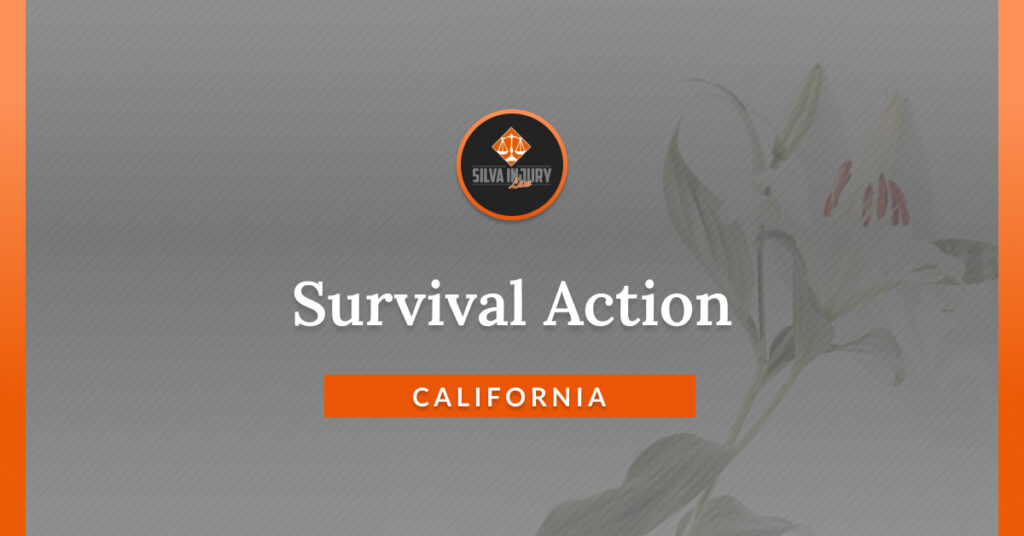
When someone survives their injuries due to another person’s negligence, chances are they may file an injury case against the responsible party.
However, some victims may die before they can seek compensation, leaving families emotionally and financially devastated.
By filing a survival action claim in California, the head of the victim’s estate can pursue the compensation owed to the victim before their death on their behalf. Our experienced California wrongful death lawyers will explain.
For a free consultation, please call (209) 600-4389 or fill out our online form today.
What Are Survival Action Claims In California?
In California, a survival action is any personal injury claim that the deceased filed or could have filed before their death. In many cases, the survival action will relate to the accident that caused the person’s death, but not necessarily.
For example, someone may suffer injuries in a non-fatal car accident and then die of an unrelated heart attack a year later before they have a chance to seek compensation for the car accident. A survival action would allow their estate to collect damages they would have been able to seek from the car accident if they had lived.
Under CCP 377.30, the representative of the deceased’s estate may file a survival action. In many cases, this representative is a successor-in-interest named in the deceased’s will or trust. While this is sometimes a family member of the deceased, it may also be a close friend, lawyer, or financial manager. However, survival actions may only be filed if the deceased didn’t immediately die from their injuries.
Recoverable Damages in a California Survival Action Claim
Under California Law, a survival action allows the estate to seek compensation for the deceased’s injuries. CCP 377.34 states that the representative may pursue economic, non-economic, and punitive damages sustained by the deceased before their death.
There are several economic damages that a representative may pursue in a survival action, including but not limited to:
- Medical bills for the treatment of the deceased before their death;
- Damage to the deceased’s property related to their injuries; and
- Lost wages of the deceased between the date of injury and death.
Non-economic losses, such as disfigurement, loss of quality of life, or pain and suffering, are now recoverable as well. California enacted a new law that went into effect on January 1, 2022, allowing plaintiffs to seek damages for the decedent’s pre-death general damages. These damages were previously unavailable in a survival action.
It’s important to note that the law is set to expire on January 1, 2026. The California Legislature might reassess the bill at that time. Any plaintiffs who recover non-economic damages in a survival action during this time will need to report their awards to the Judicial Council. The Judicial Council is compiling the information and reporting back to the California Legislature.
The change in law affects many types of personal injury claims, including medical malpractice. However, survival actions involving medical malpractice will still be subject to the general damages cap. Under California’s Medical Injury Compensation Reform Act (MICRA), the limit has been $250,000 since 1975. Starting in 2023, the cap for non-economic damages will increase annually.
For wrongful death medical malpractice survival actions, the non-economic damages cap will be $500,000 and increase over the next 10 years to reach $1 million. After that, the cap will go up 2% annually to account for inflation.
Depending on the nature of the incident, the court may decide to award punitive damages as well. However, this is only in cases where the defendant showed a willful, reckless disregard for the safety or rights of others.
California Statute Of Limitations For A Survival Action Claim
The statute of limitations for a survival action in California is slightly different from a wrongful death case. Under CCP 366.1, as long as the statute of limitations had not yet expired by the time of the person’s death, a survival action may be brought either within six months after the victim’s death or two years from the date of the injury, whichever comes last. Consider the following example of the statute of limitations:
On January 1, 2021, John gets into a car accident with a drunk driver and suffers a traumatic brain injury. Although he survived the initial incident, John’s injury leads to a series of strokes, which eventually send him to the hospital one year later. In January 2022, one year after receiving his injuries, John dies from a stroke at the hospital. Based on this fact, his estate has until January 1, 2023, to file a survival action.
In this case, since the victim died only one year after their injury, the estate has two years from the date of injury to file the claim. If the victim died on December 1, 2022 instead—23 months after the injury—the estate would have until June 1, 2023 to file, six months after the death.
Lost A Loved One Due To Another’s Actions? We Can Help
If you’ve lost a loved one due to a wrongful death or other personal injury, you don’t need to fight it alone. At Silva Injury Law, Inc., our experienced wrongful death attorneys treat you like family. While money cannot replace the comfort and presence of a loved one, we passionately pursue the compensation your family needs.
To schedule a free in-person or remote consultation, call us at (209) 600-4389 or contact us online today. We proudly serve clients throughout California from our offices in Monterey, Modesto, Merced, Turlock, San Luis Obispo, Salinas, and Hilmar.
Learn More
At Silva Injury Law, we promote healing through compassionate advocacy. With each case tailored to the individual, we look our for your best interests by evaluating your unique circumstances.


